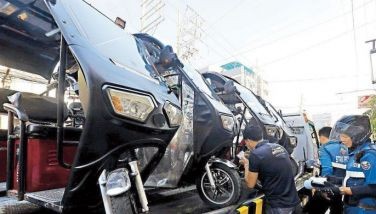Phivolcs: Several Metro Manila areas prone to liquefaction
MANILA, Philippines - The Philippine Institute of Volcanology and Seismology (Phivolcs) yesterday urged Filipinos, especially those living in liquefaction-prone areas as well as those in Metro Manila, to build strong houses and buildings.
Phivolcs director Renato Solidum Jr. said liquefaction could happen after a massive earthquake and several communities along coastal areas in Metro Manila and nearby provinces could be affected.
Liquefaction is the process by which wet sediment starts to behave like liquid. It occurs because of the increased pore pressure and reduced effective stress between solid particles generated by the presence of liquid. It is often caused by severe shaking, especially that associated with earthquakes.
Solidum said coastal areas in the cities of Marikina, Pasig, Taguig, Caloocan, Malabon, Navotas, Marikina, Muntinlupa, Pasay, Las Piñas and the municipality of Pateros are prone to liquefaction.
Aside from Metro Manila, Solidum said several areas in the provinces of Pampanga and Nueva Ecija are also susceptible to liquefaction.
These findings, he said, were part of the 2004 study conducted by Phivolcs along with the Metro Manila Development Authority (MMDA).
In an interview, Solidum said the threatened communities include tens of thousands of people living along Laguna de Bay, Barangay Putatan in Muntinlupa City, and communities along Manila Bay such as the Baseco compound in Tondo.
He said the areas prone to liquefaction also include reclaimed lands such as portions of Roxas Boulevard.
However, Solidum said well-designed and properly built buildings are protected from liquefaction if a strong quake hits.
He also underscored the need to establish community-based early warning system in these areas to reduce damage and casualties.
DepEd monitors school buildings
In a related story, engineer Oliver Hernandez, officer-in-charge of the Department of Education (DepEd) Administrative Service and chief of the Physical Facilities and Schools Engineering Division (PFSED), said that 107 out of 778 defective school buildings nationwide discovered by a Department of Public Works and Highways (DPWH) task force from March to April 2010 are located in Metro Manila.
The previous Metro Manila-wide building inspection, according to Hernandez, covered about 86 public schools and 418 school buildings.
He said the DepEd-PFSED was conducting a re-evaluation of all school buildings in Metro Manila identified to have questions on their structural integrity.
“We’re now conducting a re-evaluation. We hope to finish it by this Friday,” Hernandez said in a press conference to present the DepEd’s disaster preparedness program presided over by Undersecretary for Legal Affairs and spokesman Alberto Muyot.
“We have engineers assigned in all our regions all over the country and they will inspect all school buildings in their respective areas,” he said.
Hernandez said that the findings of structural defects in the 107 school buildings in Metro Manila were immediately acted upon, with a number of schools condemned and new buildings planned to replace them, while some with minor problems were given remedial work.
The minor defects the building inspectors uncovered ranged from hairline cracks on the columns and posts to exposed steel bars.
Hernandez also confirmed that DepEd was now coordinating with Phivolcs to verify a report that a Quezon City public school, the Bagong Silangan Elementary School in Fairview, stood right on the West Valley Fault.
The Quezon City government, he said, was already looking for a relocation site for the school.
Robredo eyes disaster preparedness
Meanwhile, Interior Secretary Jesse Robredo urged barangay officials to discuss with their constituents disaster preparedness during the scheduled nationwide barangay assembly on Saturday.
“The unfortunate tragedy that hit Japan should serve as a wake-up call for the government, including the barangays, to set up effective disaster prevention and mitigation mechanisms to prevent the unnecessary loss of lives and destruction to properties during catastrophes,” Robredo said.
He said Saturday’s activity will also enable barangay officials to inform their constituents on disaster protocols, including what to do before, during and after a calamity.
The event was in accordance with Proclamation 342 and the Local Government Code, requiring the conduct of a barangay assembly every first Saturday of March and third Saturday of October.
Robredo said the assembly would be the best opportunity for barangay officials to discuss with their constituents the level of preparedness or readiness of their barangays in case a major disaster strikes.
He also enjoined them to discuss with their constituents problems and issues on solid waste management, as well as on the scheduled nationwide planting of 25,000 seedlings on June 25 to coincide with Philippine Arbor Day under the Billion Trees Program. – Cecille Suerte Felipe, Rainier Allan Ronda
- Latest
- Trending


























